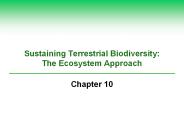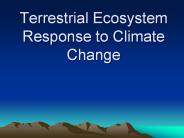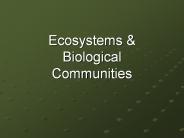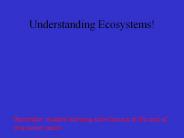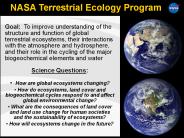Terrestrial Ecosystem PowerPoint PPT Presentations
All Time
Recommended
Ecosystems, ecosystem management, ecosystem health
| PowerPoint PPT presentation | free to view
Terrestrial Ecosystem Response to Climate Change
| PowerPoint PPT presentation | free to view
Sustaining Terrestrial Biodiversity: The Ecosystem Approach G. Tyler Miller s Living in the Environment 14th Edition Chapter 11 Key Concepts Human land use Types ...
| PowerPoint PPT presentation | free to download
Sustaining Terrestrial Biodiversity: Managing and Protecting Ecosystems Chapter 10 ...
| PowerPoint PPT presentation | free to view
What kinds of questions should define a broad-based environmental observatory ... Studies: 'We in the east are battling wave after wave of exotic forest pests. ...
| PowerPoint PPT presentation | free to view
Chapter 6: Ecosystems and Ecosystem Management Watershed The whole region or extent of land which contributes to the supply of a river, lake or ocean.
| PowerPoint PPT presentation | free to view
Ch 8: Nutrient Regeneration in Terrestrial and Aquatic Ecosystems
| PowerPoint PPT presentation | free to view
Aquatic Ecosystems Ecosystem Ecology
| PowerPoint PPT presentation | free to view
Sustaining Terrestrial Biodiversity: The Ecosystem Approach Chapter 10
| PowerPoint PPT presentation | free to download
# Italy 20,089; France 19,490; Spain 15,090; Germany 9,355. ^ Estimation. Total probably higher. India ... managed by humans ... Forest ) coniferous ...
| PowerPoint PPT presentation | free to download
Chapter 10 Fern Gully Sustaining Terrestrial Biodiversity: The Ecosystem Approach * Figure 10.20 Solutions: ways to protect tropical forests and use them more ...
| PowerPoint PPT presentation | free to download
BIOL 4120: Principles of Ecology Lecture 18: Ecosystem Ecology (Energy in the Ecosystem) Dafeng Hui Office: Harned Hall 320 Phone: 963-5777 Email: dhui@tnstate.edu
| PowerPoint PPT presentation | free to download
... all the living and nonliving parts of an environment Biotic ... oceans, estuaries, and ... design template Ecosystems What effects do biotic and abiotic factors ...
| PowerPoint PPT presentation | free to view
Sustaining Terrestrial Biodiversity: The Ecosystem Approach Chapter 10 * * * * * National park a reserve of land, usually, but not always declared and owned by a ...
| PowerPoint PPT presentation | free to download
Chapter 8: Nutritional Regeneration in Terrestrial and Aquatic Ecosystems Robert E. Ricklefs The Economy of Nature, Fifth Edition
| PowerPoint PPT presentation | free to download
Depth of Channel Incision. Stream Network. So where do you start to reverse the degradation caused by incision or gullying? Ash Swale ...
| PowerPoint PPT presentation | free to view
Global Change and Terrestrial Ecosystems. To study the ... GCTE Elevated CO2 Network. GCTE Focus 3 Wheat Network. Research Strategies (i): Glue Activities ...
| PowerPoint PPT presentation | free to view
ENERGY TRANSFER IN ECOSYSTEMS Unit Target: Research ways in which organsisms in an ecosystem get the materials and energy they need. In the last unit we learned that ...
| PowerPoint PPT presentation | free to download
Mapping a terrestrial ecosystem. by. Donizeti Antonio Giusti. Setuko Masunari. Abstract ... Map a small terrestrial ecosystem using the GIS program. ...
| PowerPoint PPT presentation | free to view
Chapter 10 Sustaining Terrestrial Biodiversity: The Ecosystem Approach Chapter Overview Questions How have human activities affected the earth s biodiversity?
| PowerPoint PPT presentation | free to view
Ecosystems Ch. 21 Ch. 21.1 Terrestrial Biomes Biome: -large climatic regions that contains groups of ecosystems. -temperature and amount of precipitation as well as ...
| PowerPoint PPT presentation | free to view
Continental, Landscape, and Ecosystem Scale Fluxes of CO2, CO, and other Greenhouse Gases: Constraining Ecosystem Processes from Leaf to Continent
| PowerPoint PPT presentation | free to download
What effects do biotic and abiotic factors have on an ecosystem? Diane Gioia Bell s Crossing Elementary What makes up an ecosystem? Ecosystem all the living and ...
| PowerPoint PPT presentation | free to view
Forests and climate change: Observations of the role of terrestrial ecosystems in the earths carbon
| PowerPoint PPT presentation | free to view
Chapter 23 Sustaining Terrestrial Biodiversity: The Ecosystem Approach
| PowerPoint PPT presentation | free to view
Jonathan Shurin1, Jessie Clasen2, Andrea English1, Aimee Pelletier1 and Thalia Zis1 ... Can plant:herbivore stoichiometry explain why aquatic ecosystems have: ...
| PowerPoint PPT presentation | free to view
| PowerPoint PPT presentation | free to view
This includes diversity within species, between species, and of ecosystems ... Ecosystem services are the benefits people obtain from ecosystems ...
| PowerPoint PPT presentation | free to download
... NatureServe to develop the classification (Josse et al 2003), but had no map ... Data for Brazil was compiled at 1:1,000,000 scale with the remainder of South ...
| PowerPoint PPT presentation | free to download
Deforestation will probably have serious long-term irreversible effects on the climate of the Amazon Basin. ... The ecosystem has living (biotic) and non-living ...
| PowerPoint PPT presentation | free to view
BIOL 4120: Principles of Ecology Lecture 18: Ecosystem Ecology (Energy in the Ecosystem) Dafeng Hui Office: Harned Hall 320 Phone: 963-5777 Email: dhui@tnstate.edu
| PowerPoint PPT presentation | free to download
Simulating NPP and ET of Terrestrial Ecosystem in China using BPES Model
| PowerPoint PPT presentation | free to view
Ecosystems Pond Living things: Fish Ducks Frogs Bugs Non living things: Rocks Sticks Litter Leaves Species Interactions Kinds of Ecosystems There are terrestrial and ...
| PowerPoint PPT presentation | free to download
Terrestrial ecosystems play important role in the global climate system and ... (Boston University); Nancy Kiang, Randal Koster, Jeffrey Privette (GSFC, NASA) ...
| PowerPoint PPT presentation | free to download
Ecosystems Ch.21 (21-1) Terrestrial Biomes Biomes: large terrestrial ecosystems that contain smaller ecosystems w/in them 7 major biomes 7 Major Biomes Tundra Very ...
| PowerPoint PPT presentation | free to download
Ecosystems Chapter 28
| PowerPoint PPT presentation | free to view
Ecosystem HO Pui-sing Contents What is an ecosystem Three major principles of ecosystem Components of an ecosystem Abiotic components Biotic components Movement of ...
| PowerPoint PPT presentation | free to download
Ecosystems Chapter 48
| PowerPoint PPT presentation | free to download
Ecosystems Chapter 48
| PowerPoint PPT presentation | free to download
Ecosystem Components BIOTIC Components of an Ecosystem PRODUCERS CONSUMERS DECOMPOSERS (type of Consumer) PRODUCERS (autotrophs) Terrestrial: Green plants Aquatic ...
| PowerPoint PPT presentation | free to view
Ecosystems & Biological Communities Nitrogen Cycle Plant growth is limited by the availability of nitrate and ammonia in the soil. Most farmers add nitrates to the ...
| PowerPoint PPT presentation | free to download
Ecosystems Nitrogen Cycle What form does most nitrogen exist in? Nitrogen gas in the atmosphere (N2) Why is this a bad thing? This form is not readily usable by most ...
| PowerPoint PPT presentation | free to download
Chapter 4 Ecosystems & Communities Weather and Climate Weather is the day-to-day condition of Earth s atmosphere. Climate refers to average conditions over long ...
| PowerPoint PPT presentation | free to download
Humans throw away tons of garbage Every year as unwanted, unneeded, And unusable. But, nature never throws anything Away. Biogeochemical Cycles The physical parts of ...
| PowerPoint PPT presentation | free to view
Chapter 3 Ecosystems: What Are They and How Do They Work? SOIL: A RENEWABLE RESOURCE Soil is a complex mixture of: Eroded rock Mineral nutrients Decaying organic ...
| PowerPoint PPT presentation | free to download
Chapter 51 Ecosystems Ecosystems Population: all the individuals of a certain species that live in a particular area Community: all the different species that ...
| PowerPoint PPT presentation | free to download
Chapter 6 Ecosystem Balance
| PowerPoint PPT presentation | free to download
Understanding Ecosystems!
| PowerPoint PPT presentation | free to view
Understanding Ecosystems! Reminder: student learning activities are at the end of this power point.
| PowerPoint PPT presentation | free to download
Food Webs Within Ecosystems Marine, Freshwater, and Terrestrial FOOD WEBS Ecosystems A community of organisms interacting with one another and their environment ...
| PowerPoint PPT presentation | free to view
Aquatic Ecosystems Chapter 7
| PowerPoint PPT presentation | free to view
detritus = dead animals and plant tissue, consumed by 1 decomposers (bacteria, ... Large amounts of S leave ecosystem as detritus (washes into streams) ...
| PowerPoint PPT presentation | free to view
NASA Terrestrial Ecology Program Goal: To improve understanding of the structure and function of global terrestrial ecosystems, their interactions with the atmosphere ...
| PowerPoint PPT presentation | free to download
ecosystem recycling in energy flows through ecosystem water nitrogen carbon phosphorus are recycled!!! they move thru a biogeochemical cycle: abiotic (non ...
| PowerPoint PPT presentation | free to view
Ecosystem Recycling Matter must be recycled and reused Substances pass between living and nonliving worlds Water, carbon, nitrogen, calcium, phosphorus Biogeochemical ...
| PowerPoint PPT presentation | free to download
Terrestrial Ecology Notes
| PowerPoint PPT presentation | free to view









